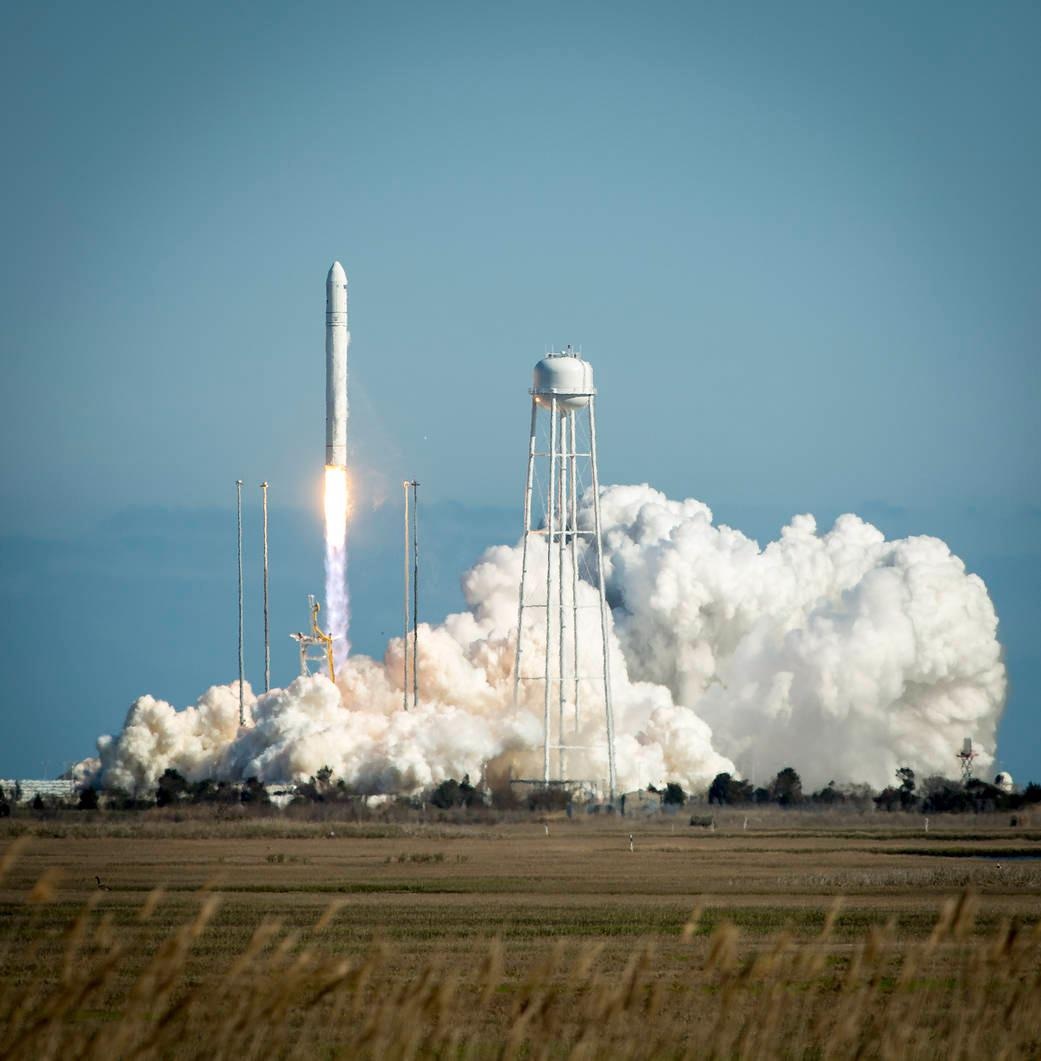According to a new University of California, Riverside (UCR) study, a chemical employed in the batteries of an electric vehicle could also provide carbon-free fuel for space travel.
 The Orbital Sciences Corporation Antares rocket launching from the Mid-Atlantic Regional Spaceport at the NASA Wallops Flight Facility in Virginia. (Image Credit: NASA/Bill Ingalls).
The Orbital Sciences Corporation Antares rocket launching from the Mid-Atlantic Regional Spaceport at the NASA Wallops Flight Facility in Virginia. (Image Credit: NASA/Bill Ingalls).
Besides emission cutbacks, this chemical also has numerous benefits over other types of rocket fuels such as lower costs, higher energy and not requiring frozen storage.
The chemical, ammonia borane, is presently employed for the storage of hydrogen in fuel cells that drive electric vehicles. UCR scientists, at present, understand how this mixture of hydrogen and boron can discharge sufficient energy to also launch satellites and rockets.
We are the first to demonstrate that in addition to electric vehicles, ammonia borane can be used to make rockets go too, under the right conditions.
Prithwish Biswas, Chemical Engineer and Study First Author, UCR
Their demonstration has recently been reported in The Journal of Physical Chemistry C.
The most frequently used rocket fuels are hydrocarbon-based and are identified to have a range of negative environmental effects. They can cause cancer, poison the soil for decades and create ozone holes, acid rain and greenhouse gases like carbon dioxide.
By contrast, ammonia borane, once burned, discharges the benign compounds boron oxide and water. “It is much less harmful to the environment,” said Biswas.
In comparison with hydrocarbon fuels, ammonia borane also discharges more energy, potentially bringing about cost savings because less of it is needed to fuel the same flight.
To discharge energy from the fuel and facilitate combustion, oxidizers and catalysts are incorporated to supply additional oxygen to the fuel. Fuel cells frequently employ catalysts for this reason. They improve the combustion rate, and they also remain in the same form both before and after the reaction.
Spacecraft require high amounts of energy in a short amount of time, so it’s not ideal to use a catalyst because it doesn’t contribute to the energy you need. It’s like dead mass in your gas tank.
Pankaj Ghildiyal, Ph.D. in Chemistry and Study Co-Author, UCR
The characteristic chemistry of ammonia borane decomposition obstructs the discharge of its total energy on reaction with the majority of oxidizers. However, the scientists discovered an oxidizer that modifies the decomposition and oxidation mechanisms of this fuel, resulting in the extraction of its overall energy content.
This is analogous to the use of catalytic converters to enable the complete combustion of hydrocarbon fuels. Here, we were able to create more complete combustion of the chemicals and increase the energy of the entire reaction by using the chemistry of the oxidizer itself, without needing a catalyst.
Pankaj Ghildiyal, Ph.D. in Chemistry and Study Co-Author, UCR
As well as producing unwanted byproducts, certain rocket fuels also need storage at sub-freezing temperatures.
“NASA has used liquid hydrogen, which has very low density,” Ghildiyal said. “It, therefore, requires a lot of space as well as cryogenic conditions for maintenance.”
Conversely, this fuel is stable at ambient temperature and is impervious to high heat. In this study, the scientists developed very fine, nanoscale particles of ammonium borane, which could degrade during the course of a month in extremely humid surroundings.
The researchers are presently exploring the way ammonium borane particles of different sizes age in diverse environments. They are also formulating techniques of encasing particles of the fuel in a protective coating, to improve their stability in moist environments.
This study was directed by Michael R. Zachariah, UCR chemical engineering professor, and financially supported by the U.S. Defense Threat Reduction Agency’s University Research Alliances program as well as the Office of Naval Research. The agencies granted the funds to help produce cleaner, more effective flight fuels.
The quantum chemistry calculations needed to assist the experimental observations in this research were carried out in partnership with UCR material researchers Hyuna Kwon and Bryan M. Wong.
Pankaj Ghildiyal received his Ph.D. from the University of Maryland.
We’ve determined the fundamental chemistry that powers this fuel and oxidizer combination. Now we are looking forward to seeing how it performs at large scale.
Prithwish Biswas, Chemical Engineer and Study First Author, UCR
Journal Reference:
Biswas, P., et al. (2022) Rerouting Pathways of Solid-State Ammonia Borane Energy Release. Journal of Physical Chemistry C. doi.org/10.1021/acs.jpcc.1c08985.